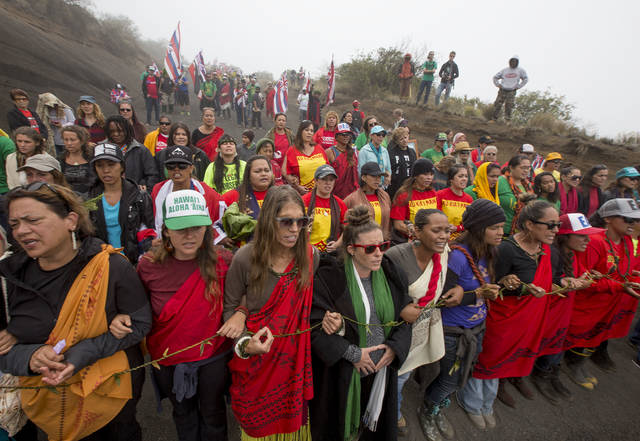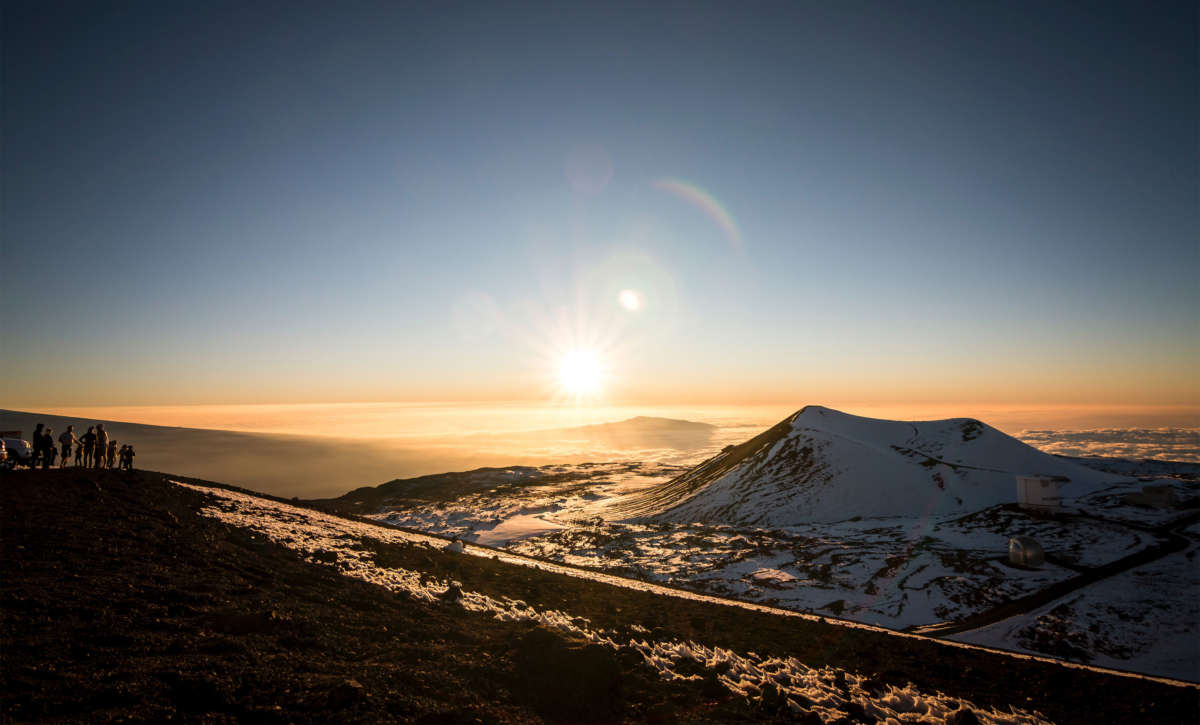Did you know that Truthout is a nonprofit and independently funded by readers like you? If you value what we do, please support our work with a donation.
“The mountain brought us together,” Luana Busby-Neff tells me. It’s 200 days into the prayer vigil and blockade that brought the proposed Thirty Meter Telescope (TMT) to a stop in Hawaii. The 14th giant telescope in Hawaii has been met with major resistance.
Busby-Neff is one of the Kapuna, or elders, who was arrested in July 2019 for protesting the construction of the TMT. This is the first major Indigenous-led occupation since Standing Rock, and, like Standing Rock, it’s a moment that unites people and understanding with water and land.
Thousands have come. Looking through the lens of a battle over the TMT, one also sees a story which is not just about a telescope, but about who gets to decide the future and understand and interpret the world. It’s about whether we will look to the stars or to the Earth. And it is about if we want bombs or water.

It’s a time of the Kiai, or the Protectors. This is the place where the Earth is born. Mauna Kea is considered an origin of Hawaiian cosmology, a Hawaiian equivalent to Christianity’s Garden of Eden. It is the meeting place of Earth Mother, Papahānaumoku, and Sky Father, Wākea. One of the farthest and most remote set of islands in the world is a magical land. Pele, the Hawaiian goddess of fire and volcanoes, both destroying and giving birth to new land and the Earth, rules. That was obvious in 2018, when a four-month lava flow out of the Kilauea volcano transformed the landscape of the island, vaporizing a lake, covering a bay and toasting as many as 700 homes. Pele is a force to be reckoned with, and not one which can be controlled by man. Mauna Kea is not only home to Pele and to some 13 giant telescopes, but it’s also home to a huge military bombing range.
On July 17, 2019, Native Hawaiian Mauna Protectors faced off with 200 riot police on the Hawaiian Homesteads Road to the proposed site of the $1.4 billion TMT. Protectors watched as the oldest among them were carted off, one by one, by police.
“They first arrested our 80-year-old Kapuna. Kapunas are the bedrock of the communities, they created our front line,” Busby-Neff says. “We are charged with obstruction of the road. We really shouldn’t be charged.”
They arrested 35 people that July day.
The Kapu System
“This camp works under strict discipline. Everything is based on ritual and based on the framework of our ancestors,” Pua Case, one of the leaders in the Mauna Kea movement, tells me. “Our traditional practice includes Cities of Refuge, a Kapu system and village system. That’s the model we use here, our traditional governance and organization.” This means there’s a list of rules, and those who are there agree to the rules, including no alcohol and no smoking of any kind. “That keeps us clean,” Case says.
Indeed, this is a well-run camp. Modeled after Standing Rock, the medical tent at the Mauna camp is staffed by doctors and health practitioners, and includes an examination room, many basic medical supplies, a room for acupuncture and traditional healing massage. “We are keeping the camp small for now,” a medic told me in the middle of January 2020.
Each day, people gather three times a day for ceremony, morning, noon and night. “That way, we remember why we are here,” Case says. New arrivals are encouraged to sign in at an orientation station. There is a tented cafeteria providing free meals, a community-run medic station, daycare and school. “We set up a university,” one of the professors tells our group. “There are over 200 classes being taught here. We are also challenging who gets to set up a university.”
It doesn’t look like anyone is going anywhere soon. The camp is flourishing. Kealoha Pisciotta is one of the Kiai leaders and a spokesperson for the Mauna Kea Anaina Hou (people who pray for the mountain). “It’s a temple. You can’t make war in a temple,” Pisciotta says. “You can stand for righteousness. It demands aloha.”
That’s a good start. Kiai water and land protectors have stopped, thus far, a $1.4 billion telescope project.
Closer to God
Scientists at the University of California and the California Institute of Technology began development of a design that would eventually become the Thirty Meter Telescope project. The Gordon and Betty Moore Foundation put up a good $200 million for the project. But construction, due originally to start in 2014, has been halted by people and courts. While Hawaii Gov. David Ige has made some promises — that TMT would be the last telescope, and the old telescopes which are no longer working (have been there for decades) will be cleaned up or decommissioned — Hawaiians are not impressed.

Mililani Trask, a Native Hawaiian and longtime political leader, was arrested at the June 2015 blockade. “By the time all the police came, we had 700 people on the Mountain,” Trask said. “The police finally began arrests.” She recalled how Kaho’okahi Kanuha, a Hawaiian language instructor who only spoke Hawaiian, “told a story of a chief long ago who had to stop an invading force from coming up the Mountain.” Speaking through an interpreter, Kanuha “explained that the Chief was his ancestor,” Trask said. In January, the verdict came back for Kanuha: he was acquitted of the charges, based on the premise that he was continuing the practice of his ancestor.
This is a story of a genealogy, a living set of beings — mountains, islands, sky and water and people. On October 30, 2018, the Hawaiian Supreme Court approved the resumption of construction, and shortly thereafter, issued an opinion creating a new legal term, the “degradation principle,” which has essentially no foundation. According to this principle, Associate Justice Michael Wilson wrote, “the degradation to the summit area has been so substantially adverse that the addition of TMT would have no substantial adverse effect.”
Governor Ige announced that construction would resume the week of July 15, 2019. That’s when the Hawaiians like Luana Busby-Neff took over the road.
Through years of legal battles and protests, Native Hawaiians and their supporters pledged to stop the telescope project at all cost. On July 15, protectors “occupied the Mauna Kea Access Road, blocking equipment trucks from ascending to the summit and drawing massive support via social media. At times the presence at the base of Mauna Kea reached 2,000 people,” the Los Angeles Times reported.
The Long Occupation
Right next to the TMT project, there’s a U.S. military facility called Pohakuloa. It’s a training range for the U.S. military to bomb the side of the island with an active volcano.
Since the end of World War II, Hawaii has been the center of the U.S. military’s Indo-Pacific Command, from which all U.S. forces in the region are directed. It serves as an outpost for Pacific expansionism, along with Guam and the Marshall Islands, Samoa and the Philippines. Its remoteness allows a wide range of weapons to be used.
U.S. military activities cover more than half the Earth, from the west coast of the U.S. to the western Indian Ocean, from the Arctic to Antarctica, covering about half of the world’s oceans. The military owns or controls more than 200,000 acres, about 5 percent of the state’s total land area. War is big business. There’s a mix of old and new military sites on the islands. In one report, the military determined that there were over 236 former military sites in Hawaii at 46 separate installations, all of which were contaminated with a multitude of military toxins.
The Pohakuloa Training Area is a 133,000-acre bombing range between the sacred mountains of Mauna Kea and Mauna Loa in the center of the Big Island, Hawaii — right next to the telescopes. At least 7 million rounds of ammunition are fired annually at that base alone. Pohakuloa has the “highest concentration of endangered species of any Army installation in the world,” according to former commander Lt. Col Dennis Owen, and it has over 250 ancient Hawaiian archaeological sites.
“We’ve been fighting telescopes and the military for 50 years,” Luana Busby-Neff says. Indeed, Hawaiians have been protecting their waters and lands since the illegal overthrow of the Hawaiian Kingdom.
We are living in a time of conflict between sacred beings and technology. It’s also the time of the Water Protector. Kalani Souza, a Hawaiian scholar talks about moving beyond the Doctrine of Discovery, to the Doctrine of Relationship. “It’s really about the water,” he says. “A name for the mountain [Mauna Kea] is also Kaohe (the water holder)…. That’s because this is the largest freshwater aquifer in the world.” This is also the place where sky and Earth meet.
Native Hawaiian traditional knowledge of realms above and below led to their success in navigating the Pacific Ocean — the largest body of water in the world. As Hawaiians contemplate the most complex of knowledge systems, the people know the Mauna is a sacred living being. Rather than being subjected to the “degradation principle,” the Mauna deserves legal recognition of the Rights of Nature, and the Rights of a Mountain.
Press freedom is under attack
As Trump cracks down on political speech, independent media is increasingly necessary.
Truthout produces reporting you won’t see in the mainstream: journalism from the frontlines of global conflict, interviews with grassroots movement leaders, high-quality legal analysis and more.
Our work is possible thanks to reader support. Help Truthout catalyze change and social justice — make a tax-deductible monthly or one-time donation today.
